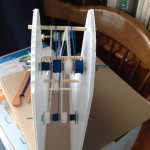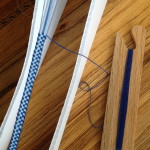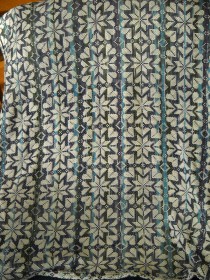 I had the opportunity to purchase a pin loom this weekend as a result of a trip to lovely Butte Montana. The day was quite enjoyable, if a bit chilly from the snow flurries. I really did not have the expectation of picking up a pin loom that day, but when I discovered it in the clearance area of a Jo-Ann’s store for 25% of its retail price, the bargain hunter in me was hooked.
I had the opportunity to purchase a pin loom this weekend as a result of a trip to lovely Butte Montana. The day was quite enjoyable, if a bit chilly from the snow flurries. I really did not have the expectation of picking up a pin loom that day, but when I discovered it in the clearance area of a Jo-Ann’s store for 25% of its retail price, the bargain hunter in me was hooked.
I brought it home and waited until dinner was complete, and cleared away. I brought it out and looked at the instructions. All I wanted to make was a simple pair of baby socks for a grandbaby that is due in the next couple of months. I figure just a couple of hours of work. Right? Oh, so so wrong!
Right? Oh, so so wrong!
I began my project by watching the video and casting on and learning how to do the knit and the purl stitches on the loom. I noticed a couple of issues for me right away. It is difficult to reach the middle area of the sock when it is set to a small size. Two start over’s and more than 8 hours later, I looked at the project and it was not all that I hoped for.

I am not a great knitter (I am a weaver). I can read and follow patterns, but often it is the counting that gets the better of me. But give me credit, I pulled out my trusty (rusty) double point needles, cast on and got started. Finding the locations of the purl stitches on the needles was easier to remember — I divided the stitches evenly so that I knew the two purl stitches were on the outside ends of the needles and never in the middle. On the pin loom I needed to use some sort of marker – the red post it tab. In less than three hours I had this sock halfway knit. Note that you are seeing the right side of the sock in this picture, but when I am knitting the right side is on the interior of the needles. (Experienced knitters don’t snicker too hard, I am handicapped – I am left handed.) I always have to peek inside to see what is going on. I completed the sock tonight with only minor trauma, when I picked up the knitting after taking this picture I forgot to turn it inside out before starting to knit… I had a four rows of purl stitches before I realized it. Off come the needles, and out come the stitches —(I was almost in despair except for a friendly crochet hook to save the day). Weaving is easier than this. Here is my final sock, a spiral tube. Has anyone woven a baby sock, and how did you accomplish your magic feat?
My assessment: the sock loom is nice and sturdy, and it works according to the instructions that come with it. It is probably designed for someone who is a bit skinnier than I (children’s – teen’s socks). According to the directions I need to cast on 88 stitches to make a sock for myself and my loom is not that big (you can only cast on 60 stitches) The loom gauge is 7 stitches per inch. The actual knitting is not difficult – the rhythm is addicting once you get going. But it is more time consuming that I thought. I think I’ll stick to the knitting needles for this particular task this time.
I have one more experiment to do with this loom, see if I can weave a bookmark on it.










































